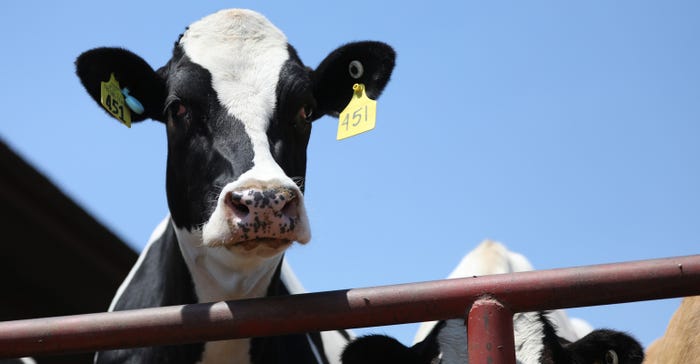
On the surface, they may look like ordinary ear tags. But DoggTags from Wyoming-based HerdDogg pack lots of info into a small package.
“Having a tag that you can put on animals and send further out … it's legitimate both for dairy and beef because of the distance of readability," says Melissa Brandao, founder of HerdDogg, making them an appealing option for farmers and ranchers looking to improve their pastured herd management.
The company is rolling out the DoggTags — Dogg is an acronym for data generator gatherer — after several years in development and has been hitting up the show circuit, most recently at World Dairy Expo.
How far is readability? Up to 100 yards, Brandao says. The tags don’t look remarkable, save for their unique yellow color. They go on an animal using a standard tag applicator.
But the data in these tags is the real selling point. The tags are powered by Bluetooth and transmit data to the company’s HerdDogg Cloud Platform, which a producer can access on a smartphone or computer. Once on the app, a producer can access all kinds of information about their animals, including real-time location, behavioral insights and point-of-care treatment.
"When the animals are out doing their animal thing, grazing, laying, you can't really get close enough to them to identify them well. And that problem became sort of an obsession of mine,” says Brandao, who worked on database management for Apple before the iPhone became a household name.
The company is marketing two types of ear tags: the TraceTag that costs $10 a tag can last up to five years, can be read from as far as 100 yards and is a straight replacement for RFID; and the WelfareTag that costs $15 a tag, lasts up to two years and has the same features as the TraceTag, but also comes with enhanced health monitoring to better detect estrus cycles.

The tags, which can be affixed to a cow using a standard tag applicator, can track a cow’s movement and detect estrus cycles.
They also sell portable readers called DoggBone that look like walkie-talkies but can be placed anywhere in a pasture or large barn, and can read the tags from up to 100 yards away. The readers collect data from the tags and connect to the cloud every 20 minutes where it’s stored, so a producer can access it later via smartphone or computer.
"We're not just providing a platform for animal welfare and management, but a lot of it is automated because we have the tags on those animals,” Brandao says. “So you're not having to do the human input energy in order to get the analytics most other platforms require.”
On-farm testing
At the WKU SmartHolstein Lab — a strategic partnership between Holstein Association USA and Western Kentucky University’s Department of Agriculture and Food Science — the tags have been affixed to 55 Holsteins at the lab’s farm demonstration farm in Bowling Green, Ky.
Jeffrey Bewley, dairy analytics scientist for Holstein USA, says the lab’s purpose is to study novel phenotypic traits in cows using the latest technologies such as wearable technologies, computer vision powered by artificial intelligence and more. It’s also a place where the practical application of a new technology can be tested and evaluated.
The DoggTags, he says, are like other technologies from companies such as Nedap and Allflex that have developed wearables that can detect cows in heat. The tags have accelerometers in them that can measure motion in three dimensions, so when a cow is in heat, the animal’s movements will become more active. Conversely, if a cow is sick, their movement will slow a bit, enabling a producer to detect an ailment earlier and possibly save the animal.
The difference is the price. While the DoggTags are more expensive than RFID tags, Bewley says they are much cheaper than companies selling similar estrus detection technologies. “They are trying to be a disruptor in that space,” he says of HerdDogg.
Brandao says small farmers, particular dairy farmers, are an important market for the tags.
"We right now on the dairy side are focused on the smaller producers,” she says. “We would like to work with producers that have not used tech before because it’s too expensive.”
Traceability
The real long-term value of the tags, Brandao says, is their potential in food supply animal traceability.
The company is working on a platform that enables data on individual animals to be accessed via QR code, so a feedlot, processor or even someone at a store can scan the code and find out lots of information about where they’re food came from.
“So if you’re a consumer and you scan that QR code on a meat package, you’re going to have the consumer element — when it was born, how long it was aged, what breed, miles traveled. So the consumer knows about the food they are buying at the store,” Brandao says. “Along with the consumer dataset, there are datasets appropriate for processors or feedlots, or anybody.”
But she insists that the producer will control the data anyone sees.
"The idea is that the cow-calf operator, the originator of the animal, really sets the dataset for the rest of the food supply,” Brandao says. “So whatever data they want to transfer along from one owner to the next. It's kind of like pictures. If you share pictures with somebody, it comes along with metadata. The only difference is that now, depending on the audience, that picture might look a little different.”
You can buy the tags and DoggBone readers in a package — ranging from $1,199 to $1,899, depending on options — or you can buy the tags themselves online. One DoggBone reader can support up to 250 tags.
For more information, visit herddogg.com.
About the Author(s)
You May Also Like






